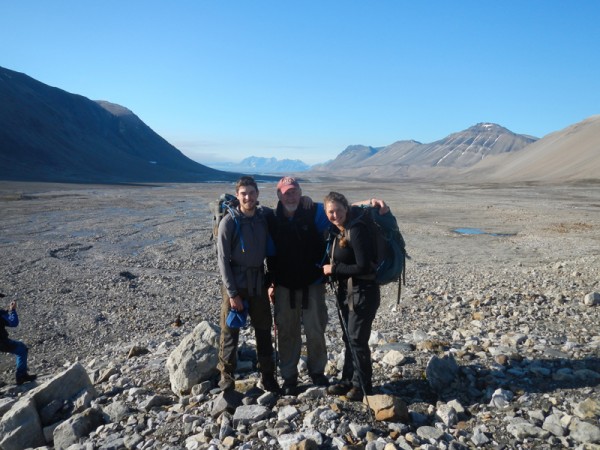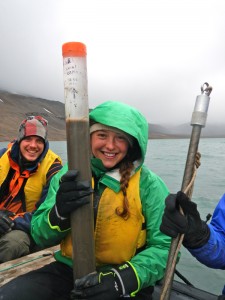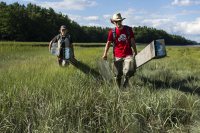
Summer Student Work: Geology major Balter studies climate change in Arctic

Alexandra Balter ’14, right, poses at a field site in Svalbard, Norway, with adviser and Professor of Geology Mike Retelle, center. Joining them in Svalbard is Greg de Wet ’11, left, who is pursuing his master’s in geosciences at the University of Massachusetts-Amherst. Photograph courtesy of Greg de Wet ’11.
Alexandra Balter ’14 discusses why she chose to spend a cold summer in the Norwegian Arctic.
Name: Alexandra Balter ’14
Hometown: Wellesley, Mass.
Majors: geology and environmental studies
Adviser: Mike Retelle, professor of geology, whose work involves several research projects in the high latitudes of the North Atlantic region.
Research Funding: STEM Faculty-Student Research Grant, the college’s endowed fund supporting students who conduct research alongside their professors in the sciences and mathematics.
1. What is your research about?
I’m studying climate change using sediment core samples from Arctic lakes in Svalbard, Norway, as part of my senior thesis. I just recovered an 84-centimeter-long core sample that should span several hundred years of sedimentation. With this sample I hope to tease out warm and cool periods in Svalbard’s past and understand more about how this lake system will respond to changes, especially as Svalbard warms.
2. What’s special about Svalbard for this kind of work?
The Arctic experiences climate change at a faster rate — and with more visible consequences — than we do at the mid-latitudes, so it is a particularly informative place to study as a climate scientist. Svalbard is an especially great place for study because it is vast and largely free of direct human influence.

Balter displays her sediment core sample from Lake Lennoré in Svalbard. Photograph courtesy of Greg de Wet ’11.
3. What made you want to spend your summer doing research in Norway? Isn’t it cold there?
In the most selfish way possible, I really wanted to experience the Arctic! My adviser, Mike Retelle, works with a group of undergraduate students here in Svalbard every summer, so when it came time to choose my thesis project, I knew I had to find a way to tag along.
As for Norway’s chilly temperatures — yes, it’s cold, but I love it! Toughing out the weather makes a hard day of fieldwork that much more satisfying.
3. What academic and personal advantages have you gotten from being in Svalbard that you couldn’t necessarily have gotten anywhere else?
Many undergraduate students in this line of research are simply given a sediment core to analyze and write about. I have the opportunity to see my project through the whole scientific process — from learning about my field site firsthand to taking a sediment core, packaging my sediment core for travel, performing lab analyses and writing about my results.
Being in Svalbard has given me a renewed appreciation for Bates, too. Bates is there to facilitate these types of experiences for all its students if they so choose. Every day that I am in Svalbard I feel proud to represent a school that is so supportive of its students.
4. What’s it like working on location with your adviser?
Mike is so knowledgeable about sedimentology and the paleoclimate of this region. It’s inspiring to see his knowledge applied in the field — and to soak some of it in myself. I am here with seven other undergraduates from around the country, a second professor, and two teaching assistants. Being part of this close-knit community in Svalbard is amazing and will definitely make gathering my results and writing my thesis all the more enjoyable.
5. Greg de Wet ’11 is doing his master’s research in Svalbard and is part of your current research group. How has he helped you think about your work?
Not only was Greg part of this same research while at Bates, but he is also pursuing a career as a climate scientist — one that I hope to follow. He’s helping me think about my life after Bates and how geology can be part of that. He is also teaching me a relatively new method for studying paleo-productivity, which I will be able to use in my thesis.




